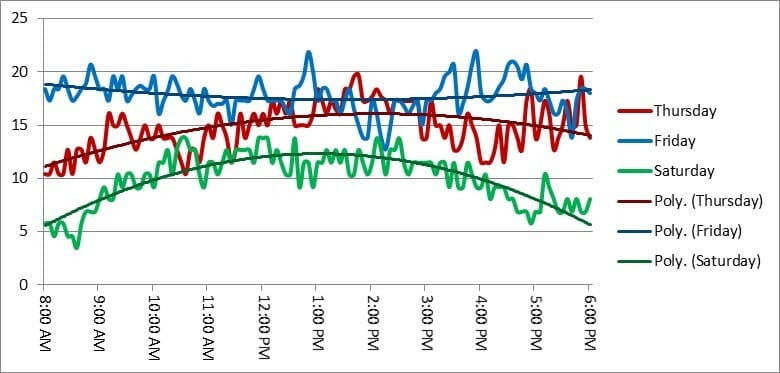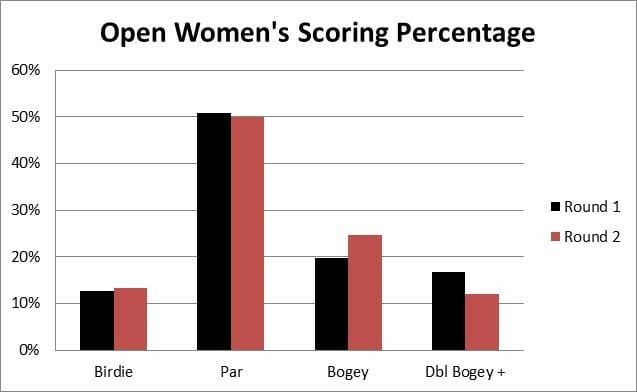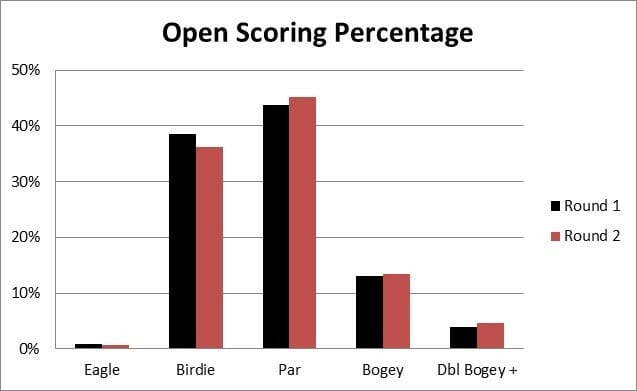A look back at weather's impact on the Waco Annual Charity Open
March 28, 2017 by Jacob Wilkins in Analysis with 1 comments
To say the wind had an effect on scores during the recent Waco Annual Charity Open in Waco, Texas, would be a vast understatement. Watching both live and post-produced coverage, it was easy to see the wind was playing a factor. We saw Ricky Wysocki miss putts we see him almost never miss; we saw players carding uncharacteristic triple bogeys on hole 5, the toughest hole on the course; and we saw players turn their discs over running for eagle on hole 6.
So I began to ask myself: Just how much effect did the wind have on scores? While ultimately this is a nearly impossible question to answer, I did find some interesting connections in my analysis of the weather and play of the event.
Being a meteorologist, I immediately began looking for the closest credible weather source in the area. A quick look at the NOAA National Centers for Environmental Information led me to a weather station located about five miles from Brazos East Park. This weather station obtained wind readings every five minutes, resulting in fairly high resolution data to work with. I ordered a data package for Thursday, Friday, and Saturday of the event, then broke the dataset down by looking at only the hours from 8:00 a.m. to 6:00 p.m. each day. This captures the full scope of action, from when the Open Women’s field teed off in the morning to the time Open wrapped up in the evening.
In general, the data supports that idea that wind speeds increase during the afternoon hours. This makes sense from a meteorological perspective as well, because as surface temperatures warm, the difference in atmospheric temperature and surface temperature increases. This increasing temperature gradient leads to a pressure gradient, which leads to the production of wind. That’s enough meteorology mumbo jumbo for now though — this is about disc golf.

The only day that did not exhibit this expected behavior was Friday. On Friday, the wind speeds actually decreased some in the middle of the day before picking up again during the late afternoon and early evening. The day that best exhibited usual characteristics was Saturday, which had a lower average wind speed. The average wind speed on each day was as follows: 14.8 mph Thursday, 17.8 mph Friday, and 10 mph Saturday.
The next component to analyze is player performance as a whole. The total amount of strokes for the 18-player Open Women’s field after the first round was 1,364. The total amount of strokes for the 75-player Open field after the first round was 4,710. However, it should be noted that Nikko Locastro was omitted from this dataset due to his car accident and subsequent accrual of 16 penalty strokes during the first four holes of the tournament.
Where things get interesting is looking at day two data. According to the scores from round two, the total number of strokes in the Open Women’s was 1,333, a decrease of 31 strokes from the day before. The total number of strokes in the Open field was 4,770, an increase of 60 strokes from round one. The interesting takeaway from this is that the wind speeds from 8 a.m. to noon – peak Women’s field time — were fluctuating between 15 and 20 mph, with an average wind speed of 18 mph. However, from noon to 4 p.m., wind speeds were fluctuating between 12 and 22 mph, with an average wind speed of 17.5 mph. This average increased back to 18.1 mph from 4 p.m. to 6 p.m., but for a majority of the Open field, sustained winds were a bit more subdued.
Total Strokes - Waco Annual Charity Open| Division | Round 1 | Round 2 | Change |
|---|---|---|---|
| Open | 4,710 | 4,770 | +60 |
| Open Women's | 1,364 | 1,333 | -31 |
Looking more closely at the scores, 12 of 18 women’s players — 66 percent — shot better in round two than they did in round one. Most notably, Lesli Todd, Courtney Cannon, and Madison Walker improved their scores by 17, 8, and 7 strokes, respectively. Only four of 18 women’s players shot worse in round two than in round one.

In the Open division, meanwhile, only 25 of the 741 players in the dataset – or just a shade over 33 percent — shot better in the second round than in the first. In fact, 45 of 74 shot worse rounds during the second round. In terms of averages, the women’s field shot an average of 1.72 strokes better per player, whereas the Open field shot 0.81 strokes worse per player.

The Open field, though, made adjustments on the third day of the tournament, as 48 players carded better final rounds than second rounds. This number led to a whopping average of 2.2 strokes better per player, with Austin McNabb, Addison Collins, Andrew Presnell, Julian Dussan, Trevor Harbolt, and Eric Oakley leading the way. Each of these players improved their scores by double digits in the third round. The women’s field saw 10 players shoot better in the third round, as opposed to the second, for an average of one stroke better per player. Tina Stanaitis and Maria Oliva saw the biggest improvement at 12 and 7 strokes, respectively. It should be noted that, according to the weather data, the wind was noticeably more mellow during the final day of the tournament as opposed to the first two days.
So what does all of this mean? For this tournament, at least, one could argue that the women handled wind conditions better than the men. This statement can be made with the backing of the data from the second round of the tournament: Despite playing in higher wind speeds than experienced in the first round, the women’s field played better as a whole during round two. This same trend was not seen in the Open field. In fact, the Open field played in conditions similar to those it experienced in round one — not only in wind speed, but also direction — and in spite of the familiarity the field, as a whole, shot worse the second round. Both fields were able to capitalize on the somewhat calmer conditions on championship Saturday, though, and it will be instructive to keep studying these discrepancies as the sample size increases throughout the season.
The actual number of Open participants was 75, but Nikko Locastro’s scores were omitted from all calculations. ↩